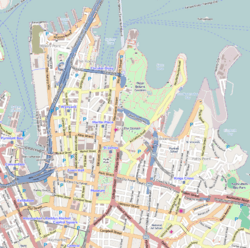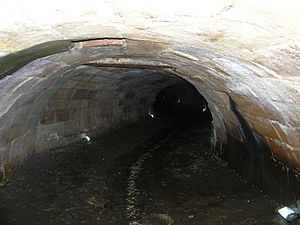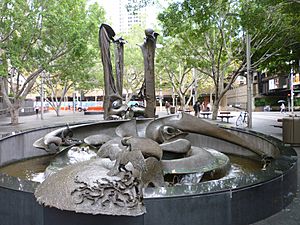Tank Stream facts for kids
Quick facts for kids Tank Stream |
|
|---|---|

Brick-lined section of the Tank Stream, pictured in November 2008
|
|
|
Location in Sydney central business district
|
|
| Country | Australia |
| State | New South Wales |
| Local government area | City of Sydney |
| Physical characteristics | |
| Main source | Hyde Park Sydney CBD 33°52′13.2″S 151°12′27.9″E / 33.870333°S 151.207750°E |
| River mouth | Sydney Cove Circular Quay 33°51′50.0472″S 151°12′31.1688″E / 33.863902000°S 151.208658000°E |
| Basin features | |
| River system | Port Jackson |
| Official name: Tank Stream; Tank Stream Fountain Circular Quay | |
| Type: | State heritage (built) |
| Designated: | 2 April 1999 |
| Reference #: | 636 |
| Type: | Spring |
| Category: | Utilities - Water |
| Builders: | Various |
The Tank Stream is a historic waterway in Sydney, Australia. It used to be a natural stream that provided fresh water. Today, it is mostly an underground tunnel and part of the city's stormwater system. It starts near what is now Hyde Park and flows into Sydney Cove at Circular Quay. This stream was super important because it was the main water supply for the first European settlers in Sydney. It is now recognized as a special heritage site.
Contents
History of the Tank Stream
The story of the Tank Stream involves both the Aboriginal people who lived here first and the European settlers. It shows how a natural stream became a vital water source, then a sewer, and finally a stormwater drain.
First People and the Stream
Before Europeans arrived, the Cadigal people lived around Sydney Cove. The area around the Tank Stream was perfect for them. It offered different environments like the sea, rivers, and forests. These areas provided lots of food and materials.
Archaeologists have found ancient stone tools near the stream. These tools were made from smooth pebbles found in the water. The Tank Stream gave the Aboriginal people fresh water, fish, and other resources.
European Settlement and Water Supply
In 1788, Captain Arthur Phillip chose Sydney Cove for the new New South Wales colony. He picked this spot because of the fresh water from the Tank Stream. The colony was first planned for Botany Bay, but there was no fresh water there.
So, Captain Phillip found Port Jackson and then Sydney Cove. He described it as having "fresh water which stole silently along through a very thick wood." The new colony officially started on January 26, 1788.
The "Tanks" and Pollution
In 1790, three or four large tanks were dug into the sandstone beside the stream. These tanks could hold about 20,000 litres of water and were 5 meters deep. This is how the Tank Stream got its name!
As more people arrived, the stream became polluted. In 1791, Governor Phillip tried to protect the water. He put a fence around the stream to stop animals from muddying it. Trenches were also dug to catch dirty runoff.
However, these efforts didn't work well. More buildings and fewer trees meant more human and animal waste entered the stream. By 1826, the Tank Stream was no longer safe for drinking. It had become an open sewer.
The Stream Goes Underground
Sydney needed a new water source, so Busby's Bore was built in 1837. After this, the Tank Stream became an official sewer in 1857. People didn't like sewage flowing directly into the harbour.
To reduce bad smells, parts of the Tank Stream were covered starting in the late 1850s. Workers built stone and brick channels with arched roofs. Over time, more sections were covered. By 1860, the swamp that fed the stream was drained.
Today, the Tank Stream is a hidden part of Sydney's stormwater system. It carries rainwater and other runoff underground. Some people have suggested bringing parts of it back above ground. This would create a unique feature in the city.
What the Tank Stream Looks Like Today
Most of the Tank Stream is now underground. It runs from near King Street all the way to Circular Quay.
The stream is made up of different sections built at various times. Some parts are modern concrete pipes. Other sections still have historic brick and stone arches from the 1800s. These older parts show how engineers built sewers long ago.
For example, between King Street and Martin Place, you can see different types of pipes. Some are modern, while others are older, oval-shaped sewers. Near Hunter Street and Bond Street, there are semi-circular stone arches. These show how the stream was covered to reduce smells.
The original stone tanks that gave the stream its name were in the Bond Street area. They are not thought to have survived. However, the underground channels themselves are a fascinating look into Sydney's past.
Visiting the Tank Stream
You can actually go on tours of the Tank Stream! Sydney Living Museums and Sydney Water organize these tours. Tickets are very popular and are usually given out by ballot (like a lottery).
Even if you can't go on a tour, you can still explore its history above ground. There are artworks, street names, and even pub names that remind people of the stream's path.
A special sculpture called the Tank Stream Fountain also celebrates its history. Created by Stephen Walker in 1981, it's located at Circular Quay.
Why the Tank Stream is Important
The Tank Stream is a very important historical site in New South Wales. It's listed on the State Heritage Register because of its huge impact on Sydney's history.
A Key to Sydney's Beginning
The stream was the main reason the First Fleet settled in Sydney Cove. Without this fresh water, Sydney might have been built somewhere else. So, the Tank Stream shaped the city we see today. It reminds us of the early days of European settlement in Australia.
A Changing Waterway
The Tank Stream has changed a lot over time. It started as a fresh water source, then became a sewer, and now it's a stormwater drain. This shows how water management in Australian cities has developed. The old stone tanks, even if they are just archaeological remains, remind us how much the early colony depended on water.
Learning from the Past
The underground sections of the Tank Stream show us how sanitation systems were designed and built in the 1800s. You can see different building methods and materials. This helps us understand how cities dealt with wastewater long ago.
Archaeologists can also learn a lot from the stream's path. They might find clues about the environment before humans arrived. They could also discover evidence of Aboriginal life and early European settlement.
A Rare Historical Site
The Tank Stream is unique because it was the only water source for the First Fleet when they arrived. It's one of the few remaining examples of early water resource development in Australia. The stream's channels also contain rare evidence of water supply and sewerage construction from the 18th and 19th centuries, all in one place.




